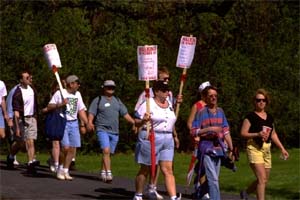
|
AIDS Treatment News
For years the AIDS community has done well in the media and in building public consensus on what needs to be done. But we have been much less effective in grassroots organizing -- in giving those who agree with us effective, satisfying actions for making their values and priorities known. Perhaps 1% of U.S. citizens who care about AIDS have ever let any of their political representatives know it. So Congress, the White House, and state and local governments seldom hear from their constituents back home. And that hurts everything that happens in AIDS. After watching this happen for years, I have become convinced that we could do much better in mobilizing popular support, by slightly refocusing some of what we are already doing. AIDS organizations and activists already have the skills and resources required. Improving Action Alerts As an example of what is needed, consider what must be changed to improve Internet action alerts so that they are truly accessible to everyone who cares, not only to experts or insiders. A year ago, it was clear that we were being hurt in Washington because members of Congress were hearing about AIDS (especially international issues) mainly from media and a few activists and professionals, but not from the voters in their districts. Since then important progress has been made. Now there are usually several action alerts and sign-on letters circulating at any one time. As a result, more people are contacting their representatives, and AIDS is treated more seriously in political circles. These action alerts vary in quality and credibility. Some include errors that could easily be fixed, such as misspellings or obsolete information. More important are judgment issues that are harder to detect -- such as whether the alert is based on a thought-out, workable strategy, or only on somebody being upset one day and wanting to do something. And many alerts try to get people to act by hammering on how bad the problem is -- while those most likely to respond already know this, but need help with other obstacles. The main problem is that unless people recognize a sponsoring organization or already know the issue very well, they have no way of knowing which action alerts they truly want to support. Therefore many alerts that may look accessible (because they correctly avoid jargon, abbreviations, or insider code meanings) are still effectively available only to those already involved. The general public, even those who completely agree on the issues, cannot use them intelligently. Even very experienced activists have sometimes had to retract their endorsement of a campaign that turned out not to be what it seemed. How can we expect people to speak out on our issue if we do not negotiate the necessary credibility up front? The Right Target Audience: Those Who Care But Are Not Already Connected
For most alerts, we suggest addressing someone who already agrees on that issue, but may live miles away from the nearest AIDS organization or activist, and not personally know anyone involved. Imagine also that this person wants to bring the alert to his or her church group, civic or political club, or other social circle -- also non-experts. An action alert package must provide exactly what is needed to do so. Probably it will include a one-page explanation, plus a background document (or Web link, preferably to a page designed for that campaign) for anyone who wants more information. People usually join causes not as individuals, but as members of social circles. Therefore, campaigns should facilitate group involvement, as well as helping individuals who want to act on their own.
These sign-on letters do help. But unfortunately they waste most of their potential, because once they are released they are finished. They do not involve the public because they give people no chance to act. Usually the letter and signatures are delivered to some office, and perhaps a press release goes out. Then it is all forgotten, because there is no follow-through. On the other hand, most action alerts do have the follow-through in public involvement -- but did not bother with consensus development. Generally they are sent out by one organization that is all but unknown outside the AIDS field. No wonder they cannot generate many letters, phone calls, or other actions requested, since only AIDS specialist can be confident that the action request is credible. Imagine what could be done by combining consensus development with actions that any supporter could take. These action alerts could break out of AIDS circles and reach many more people.
The way to get organizations to work together on a citizen- action campaign is to reach a meeting of the minds first. This requires ongoing dialog to discover areas for working together. Instead of bringing a finished product or preconceived plan, see what can be developed mutually. The AIDS catastrophe affects so many people and organizations that the opportunities for working together are endless.
Perhaps citizen action could become a practice worth doing for its own sake -- designed to guide us through effective styles of everyday living. Imagine a discipline like Tai Chi, only built on interpersonal moves instead of physical ones. (This writer started a Web site to explore the possibility, http://www.communicationpractices.org.) The bottom line is that by properly targeting our action campaigns, and negotiating the right consensus and sign-on in advance, we can involve many more people than before -- without necessarily building a major national grassroots organization, something the AIDS community has not yet been able to do. Better use of the skills we already have could increase public response many times over. We are addressing people who already agree with us on the issues. The critical need now is to provide specific actions that truly work for them. AIDS Treatment News Published twice monthly Subscription and Editorial Office: 1233 Locust St., 5th floor Philadelphia, PA 19107 800/TREAT-1-2 toll-free email: aidsnews@critpath.org useful links: http://www.aidsnews.org/ Editor and Publisher: John S. James Associate Editor: Tadd T. Tobias Statement of Purpose: AIDS Treatment News reports on experimental and standard treatments, especially those available now. We interview physicians, scientists, other health professionals, and persons with AIDS or HIV; we also collect information from meetings and conferences, medical journals, and computer databases. Long-term survivors have usually tried many different treatments, and found combinations that work for them. AIDS Treatment News does not recommend particular therapies, but seeks to increase the options available. AIDS Treatment News is published 24 times per year, on the first and third Friday of every month, and print copies are sent by first class mail. Email is available (see below). Back issues are available at http://www.aidsnews.org/ To subscribe, you can call 800-TREAT-1-2 or 415-255-0588: |
|
 Today in the U.S. we are facing one of the worst climates ever
for access to medical care and social services for AIDS and
other needs. Government budget problems, combined with the
dysfunctional financing of medical care, are threatening
Medicaid, ADAP, and the long-standing agreement that most people
with HIV in the U.S. can get treatment.
Today in the U.S. we are facing one of the worst climates ever
for access to medical care and social services for AIDS and
other needs. Government budget problems, combined with the
dysfunctional financing of medical care, are threatening
Medicaid, ADAP, and the long-standing agreement that most people
with HIV in the U.S. can get treatment.
 Action alerts should be credible, feasible, and rewarding to all
who agree on the issue -- not just AIDS specialists. Here are
some pointers:
Action alerts should be credible, feasible, and rewarding to all
who agree on the issue -- not just AIDS specialists. Here are
some pointers: